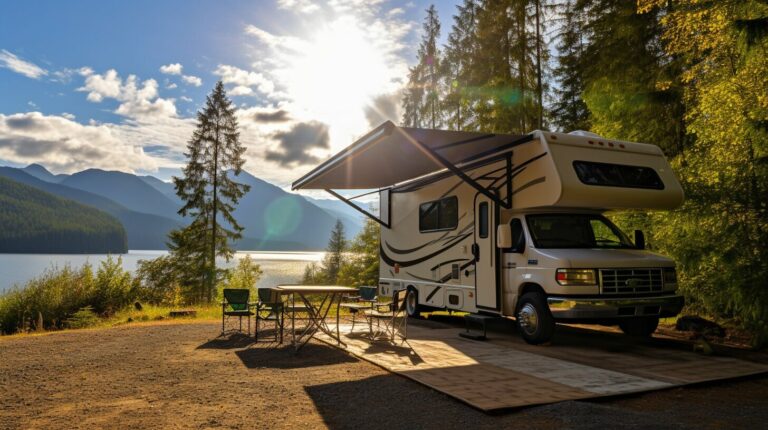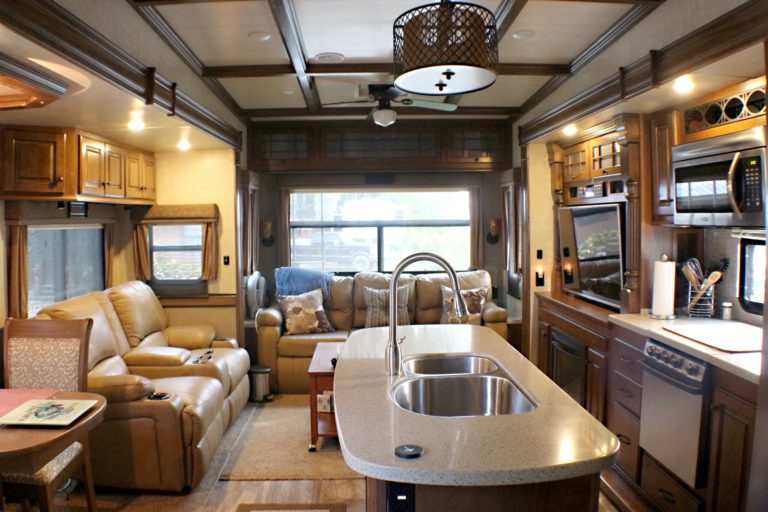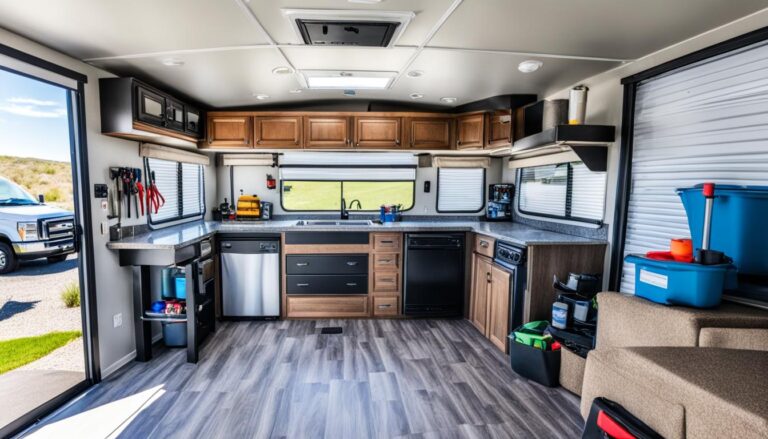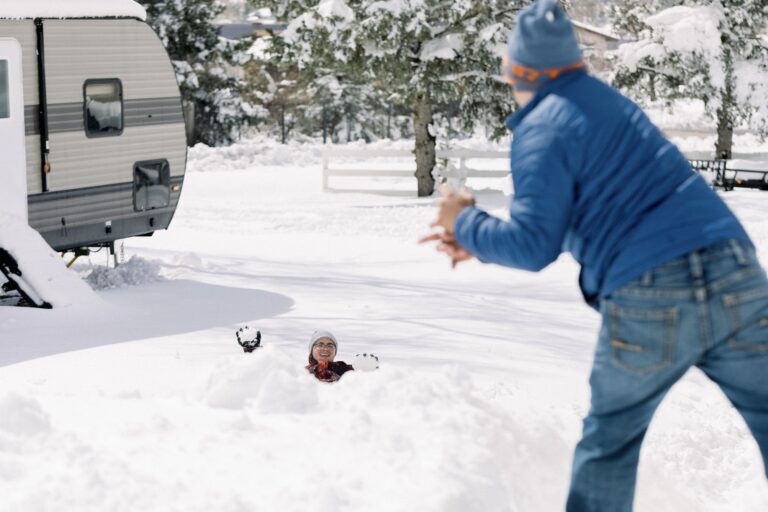Being a fan of RVs means taking care of waste disposal properly. This is very important, whether you’re out in nature or staying at an RV park. You’ll learn everything about handling RV waste in this guide. It covers different waste types and the right ways to dispose of them.
Key Takeaways
- RVs generate two main types of waste: black water (sewage) and gray water (sink and shower drainage).
- Proper waste disposal is crucial to protect the environment and comply with local regulations.
- RV dump stations are specially designed facilities where you can safely empty your RV’s holding tanks.
- RV campgrounds, state parks, and some truck stops often provide access to dump stations for RV owners.
- Maintaining your RV’s sewage system and following best practices for dumping waste can help ensure a clean and enjoyable RV experience.
Understanding RV Waste Management
Having an RV means you need to manage its waste. There are two main kinds of waste – black water and gray water. Knowing how to deal with these wastes is key for your RV’s plumbing health, meeting local rules, and being kind to the Earth.
Types of RV Waste
Black water is the waste from the toilet. It has human waste and needs careful disposal. Gray water comes from sinks, showers, and appliances. It’s less harmful but must still be handled properly.
Looking after your RV’s rv black water tank and rv gray water tank matters a lot. This care keeps your rv sewage system and rv holding tanks healthy. Not taking care of them can cause big problems and harm the environment.
Importance of Proper Waste Disposal
Disposing of RV waste the right way is very important. It’s not just about being neat. Bad disposal can lead to fines, harm the Earth, and be risky for health. Learning how to manage RV waste protects your plumbing, the environment, and makes sure you follow the law.
“Proper waste disposal is essential for the health of your RV, the environment, and yourself. It’s a responsibility that comes with the RV lifestyle, but one that’s well worth the effort.”
RV Black Water Tank: Handling Solid Waste
Your RV’s black water tank holds the solid toilet waste. It’s important to maintain and empty it regularly. Doing this stops clogs, bad smells, and other troubles. We’ll share the top methods for taking care of this tank.
Understanding the RV Black Water Tank
It’s where your RV stores toilet waste. It holds liquid and solid waste. Remember, the gray water tank only holds sink and shower water.
Taking care of your RV’s black water tank is key to a healthy sewage system. Ignoring it can cause bad smells and health risks.
Emptying the Black Water Tank
- Find the drain valve, usually at the RV’s rear.
- Attach a sewer hose tightly to it to avoid leaks.
- Open the valve slowly to let the tank empty at a proper dump site.
- Flush the tank with clean water after it’s empty.
- Then, close the valve tight and disconnect the hose.
Maintaining the Black Water Tank
- Use a tank treatment after each dump to break down waste and control smells.
- Don’t flush items like wet wipes or feminine products, as they can clog the system.
- Check the tank and its parts often for leaks or damage.
- Also, clean the tank with the right solution every few months to keep it working well.
Following these steps keeps your black water tank and RV sewage system in good shape. This way, your camping trips will be worry-free and enjoyable.
RV Gray Water Tank: Dealing with Liquid Waste
If you love RVs, you know their sewage systems come in two parts: the black water tank and the gray water tank. The black tank deals with solid waste. The gray tank handles the liquid waste from sinks, showers, and appliances.
Common Sources of Gray Water
Gray water isn’t as dangerous as black water. It comes from sinks, showers, washers, dishwashers, and A/C units. Remember, these sources are less harmful to the environment.
It’s crucial to care for your gray water tank for your RV’s health and to follow travel environment rules.
Maintenance Tips for Gray Water Tanks
For your RV’s gray water tank to work well, here are some steps to take:
- Regularly Inspect and Clean the Tank: Look for debris, buildup, or blockages. Clean your tank often to keep it working right.
- Use Eco-Friendly Cleaning Products: Pick cleaning supplies that don’t harm the environment. Make sure they’re safe for septic tanks.
- Monitor Tank Levels: Always check how full your tank is. Empty it before it overflows to prevent issues.
- Flush the System: Sometimes, flush your RV’s gray water tank and plumbing. It keeps things running smoothly.
By sticking to these tips, your gray water tank will stay in excellent shape. You can focus on your travels without waste problems.
| Common Sources of Gray Water | Maintenance Tips for Gray Water Tanks |
|---|---|
|
|
Finding RV Dump Stations
If you own an RV, disposing of its waste safely is key. Luckily, finding places with RV dump stations isn’t hard. You can look at RV campgrounds, parks, truck stops, and rest areas. This way, you can pick the best spot for you.
RV Campgrounds and Parks
RV campgrounds and parks often have on-site dump stations. These spots are perfect for RV needs. They make getting rid of black and gray water easy. Many places offer this, making it simple for guests.
Truck Stops and Rest Areas
Truck stops and rest areas are also great for dumping waste. They serve both RVs and big trucks. Before you hit the road, check where these stations are. Knowing this can help your trip go smoothly.
Planning where to dump your RV’s waste is crucial, no matter the spot you pick. It ensures a clean, fun trip for everyone. Make sure to do your homework before you go.
| RV Campground Facilities | Truck Stop and Rest Area Amenities |
|---|---|
|
|
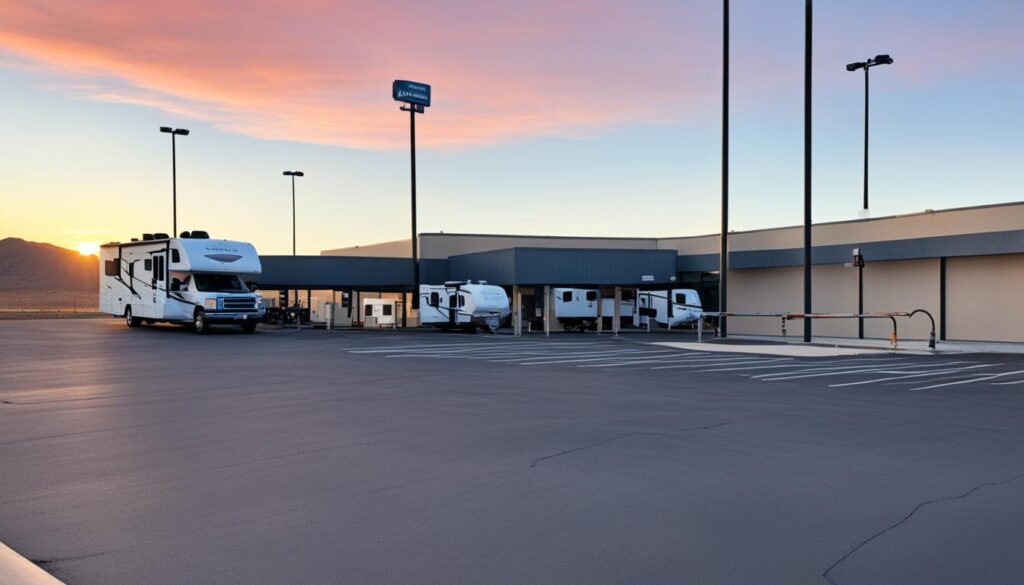
“Having a reliable RV dump station nearby is essential for maintaining the cleanliness and health of your recreational vehicle.”
Where Do RVs Dump Waste: The Process Explained
Being an RV lover means knowing the right way to get rid of waste responsibly. It’s key for both experienced RVer’s and new folks. Properly dumping waste ensures a neat and green way of living.
Start by finding a dump station, typically at RV parks, campgrounds, or truck stops. These places cater to RV needs and make waste disposal safe and easy.
- Check your waste tanks before heading to the dump station. They shouldn’t be full. This prevents messes and makes the job smoother.
- Get your gear ready, like a sewer hose and gloves. Attach it tight to your RV’s waste outlet.
- Open the black tank valve first. Let the waste drain away. Then do the same with the gray tank.
- After emptying, flush both tanks with clean water to keep them fresh. This step helps your plumbing and stops bad smells.
- Disconnect the hose, put it away clean, and leave the dump station spotless for others.
Disposing of RV waste properly is crucial for both convenience and the planet. Following these steps means you’re looking after the environment. So, when flushing your RV’s tanks, keep this process in mind to support a cleaner RV community.
“Responsible waste disposal is not just a matter of convenience, but a crucial step in preserving the natural environment for generations to come.”
RV Waste Disposal: Best Practices
Responsible rv waste disposal keeps your RV’s plumbing healthy. It also helps the environment. Following best practices ensures a safe, efficient disposal, protecting your RV and nature.
Preparing for Waste Dumping
Finding a suitable rv dump station is the first step. These places are common at RV campgrounds, truck stops, and certain areas.
Get the tools you need: a sewer hose, gloves, and a waste valve opener. Check that your hose is in good shape and connected securely. This prevents spills and makes things go smoothly.
Proper Disposal Techniques
- Open the black water tank first, allowing the solid waste to drain completely.
- Once the black tank is empty, open the gray water tank to flush out the rv sewage system.
- Use a tank rinser or flush the tanks with fresh water to remove any remaining residue.
- Dispose of the waste in the designated dump station, following the facility’s instructions and local regulations.
- Thoroughly clean and store your sewer hose and other rv sanitation practices equipment to maintain their effectiveness.
Following these practices will keep your RV plumbing working well. It also makes your rv waste disposal better for the planet.
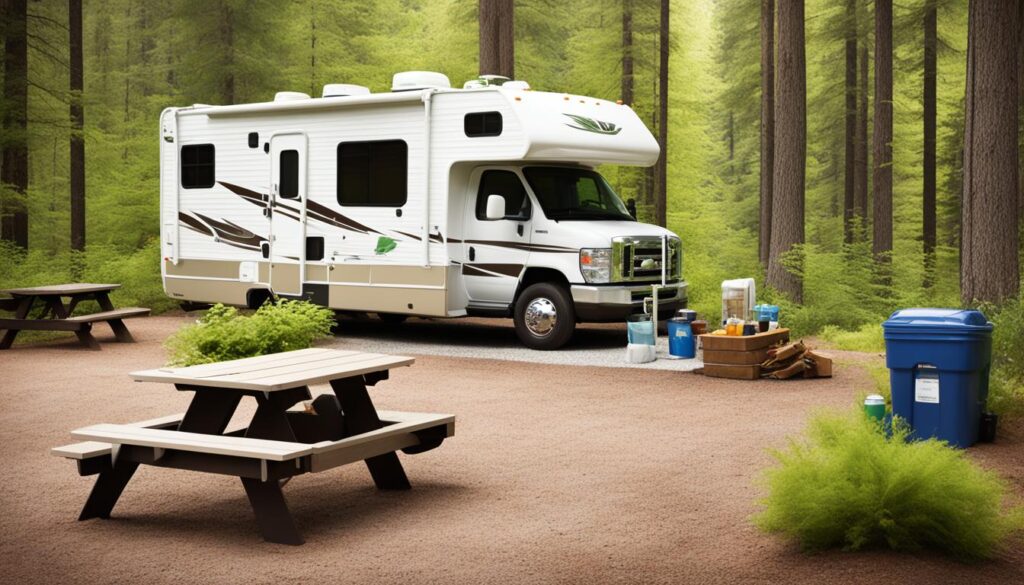
Good rv sewage system management protects the outdoors too. By sticking to these tips, you can travel in your RV knowing you’re looking after nature with rv sanitation practices.
Maintaining a Clean RV Sewage System
Keeping your RV’s sewage system clean is key to avoiding bad smells, clogs, and more. It’s important to regularly clean and flush your RV’s holding tanks. This care extends the life of your RV’s sanitation parts and makes camping more pleasant.
Cleaning and Flushing the Tanks
To keep your rv holding tanks in good shape, you need to clean and flush them. Let’s dive into how to do this:
- Cleaning the Tanks: Use an RV tank cleaner to get rid of any gunk in your tanks. Be sure to follow the cleaner’s instructions and rinse the tanks well.
- Flushing the Tanks: After cleaning, flush the tanks with clean water. This removes leftover dirt. Just attach a hose to the tank’s flush valve and run water until it’s clear.
Regular cleaning and flushing of your rv tanks keeps your plumbing smell and problem-free. This makes camping much nicer.
“Proper RV tank maintenance is crucial for a worry-free camping experience. Regular cleaning and flushing are key to avoid issues and ensure everything works well.”
How often you clean and flush depends on how much you use your RV and its type. Always check your RV’s manual or ask an expert for the best advice on taking care of your rv sewage system.
RV Sanitation Accessories and Products
Keeping your RV’s sewage system clean is crucial for a smooth camping trip. A variety of rv accessories and rv products are available. These are made to improve rv sanitation practices and make handling waste easier.
A must-have is the RV sewer hose. It helps you move waste safely from your RV to the dump. Choose hoses that are strong, won’t kink, and are easy to use. Don’t forget about sewer hose supports. They keep the hose off the ground to avoid leaks.
Need a deep clean for your tanks? Try RV holding tank treatments and cleaners. They break down waste, get rid of smells, and stop buildup. Most are made with natural enzymes or bacteria to turn solids to liquids. This leaves your tanks smelling fresh.
- RV sewer hoses and supports
- Holding tank treatments and cleaners
- Portable waste tanks and transfer pumps
- Odor eliminators and deodorizers
- Sanitation gloves and other protective gear
Portable waste tanks and transfer pumps make waste management easier. These let you carry waste from your RV to the dump station without the mess. They are very helpful for your RV’s waste.
Don’t overlook odor eliminators and deodorizers, plus sanitation gloves and protective gear. They’re key to keeping your RV waste area clean. They also ensure your camping is enjoyable.
With the right rv products and rv accessories, your RV’s sanitation system can be top-notch. This lets you fully enjoy your camping adventures.
Environmental Considerations for RV Waste Disposal
Responsible RV waste disposal goes beyond just fixing your RV’s plumbing. It’s also about lowering your impact on the environment. It’s key for RV lovers to know the harm of throwing waste the wrong way. They should also learn how to use green methods to help the Earth.
Throwing waste the wrong way can badly affect water, harm nature, and add to pollution. By using methods that are good for the Earth, RV owners help keep the beauty and resources of nature safe. This makes their outdoor trips even better.
Sustainable RV Waste Disposal Practices
- Use approved places like RV dump stations to empty your water tanks.
- Never dump waste on the ground or in water. This helps protect local nature.
- Think about using natural cleaning products for your RV.
- Get rid of dangerous waste, like used oil or batteries, at special spots.
- Tell others who love RVs about the need for sustainable waste management. It helps keep our planet clean and healthy.
Choosing sustainable ways to get rid of RV waste means your adventures leave less mess. A bit of thought and planning lets RV owners relish nature while helping save our planet’s resources.
“The true meaning of life is to plant trees, under whose shade you do not expect to sit.” – Nelson Henderson
This line reminds us our choices today can help the Earth for years. By using eco-friendly ways to manage RV waste, we make the planet better for the next group of nature fans.
Conclusion
This guide taught you about where to dump RV waste properly and why it’s important. It also showed you how to keep your RV sewage system clean and efficient. Following these tips helps you enjoy RV life and protects the environment. It also makes sure you follow the rules.
Where do rvs dump waste, rv waste disposal, and rv sanitation practices are very important. They help your RV last longer, protect nature, and follow the laws. Always look for RV dump stations before you start travelling. Also, use the right ways to manage your RV’s waste tanks.
Choosing the right rv waste disposal and rv sanitation practices helps keep our Earth beautiful for everyone. Be smart, prepare, and feel good about being a responsible RV user.

